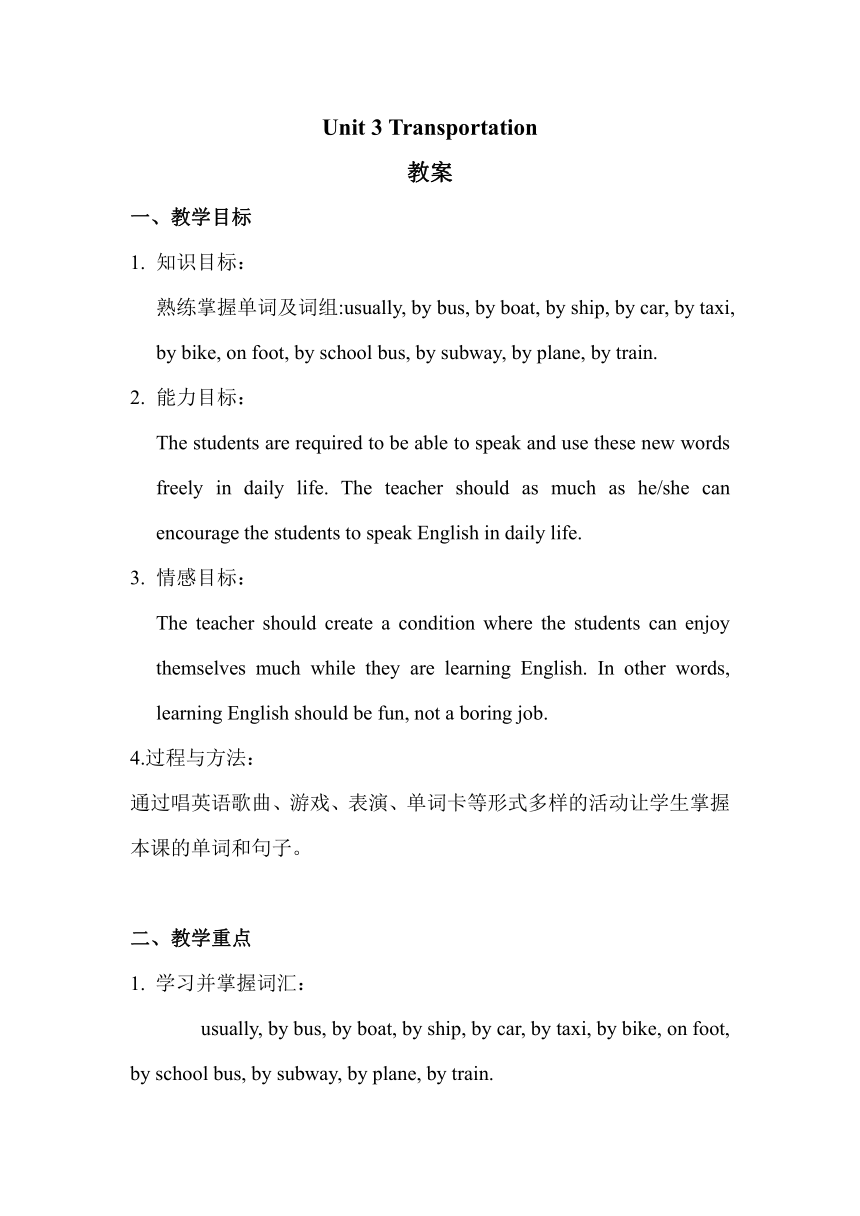Unit 3 Transportation 教案
文档属性
| 名称 | Unit 3 Transportation 教案 |  | |
| 格式 | zip | ||
| 文件大小 | 5.1KB | ||
| 资源类型 | 教案 | ||
| 版本资源 | 人教(新起点) | ||
| 科目 | 英语 | ||
| 更新时间 | 2016-12-14 10:39:10 | ||
图片预览

文档简介
Unit
3
Transportation
教案
教学目标
知识目标:
熟练掌握单词及词组:usually,
by
bus,
by
boat,
by
ship,
by
car,
by
taxi,
by
bike,
on
foot,
by
school
bus,
by
subway,
by
plane,
by
train.
能力目标:
The
students
are
required
to
be
able
to
speak
and
use
these
new
words
freely
in
daily
life.
The
teacher
should
as
much
as
he/she
can
encourage
the
students
to
speak
English
in
daily
life.
情感目标:
The
teacher
should
create
a
condition
where
the
students
can
enjoy
themselves
much
while
they
are
learning
English.
In
other
words,
learning
English
should
be
fun,
not
a
boring
job.
4.过程与方法:
通过唱英语歌曲、游戏、表演、单词卡等形式多样的活动让学生掌握本课的单词和句子。
二、教学重点
1.
学习并掌握词汇:
usually,
by
bus,
by
boat,
by
ship,
by
car,
by
taxi,
by
bike,
on
foot,
by
school
bus,
by
subway,
by
plane,
by
train.
2.
学习本节课的重点语句:
How
do
you
usually
go
to
school
/
I
usually
go
school
by
bus/car/bike…
教学难点
学习本节课的重点语句:
How
do
you
usually
go
to
school
/
I
usually
go
school
by
bus/car/bike…并引导学生们进行巩固和拓展训练。
使学生明白
often,
always,
usually之间的细微差别。
四、教学过程
Step1
Greeting:
T:
Class
begins.
S:
Good
morning
/
Good
afternoon
teacher.
T:
Good
morning
/
Good
afternoon
children.
S:
Sit
down,
please.
Step
2
Presentation:
引入并讲解新单词by
bus,
by
boat,
by
ship,
by
car,
by
taxi,
by
bike,
on
foot,
by
school
bus,
by
subway,
by
plane,
by
train.
Teach
the
words
“by
bike”
出示一张骑自行车的图片。
T:这位小朋友在干什么啊?
S:骑自行车。
T:Right,
他正在骑自行车。(出示单词by
bike,
领读几遍,然后抽查学生读,且加以纠正其发音。)
1.出示
by
bus,
by
boat,
by
ship,
by
car,
by
taxi,
by
bike,
on
foot,
by
school
bus,
by
subway,
by
plane,
by
train.等图片。
2.老师带领学生认读和理解所有生词,并熟练运用新学句型。
Step
3
Practice:
让同学们对句子How
do
you
usually
go
to
school
/
I
usually
go
school
by
bus/car/bike…进行操练。
Ss1:
How
do
you
usually
go
to
school
Ss2:
I
usually
go
school
by
bike.
Ss3:How
do
you
usually
go
to
school
Ss4:I
usually
go
school
on
foot.
Step
4
Homework:
做一个小调查,你身边的小伙伴们是怎么去上学的。
3
Transportation
教案
教学目标
知识目标:
熟练掌握单词及词组:usually,
by
bus,
by
boat,
by
ship,
by
car,
by
taxi,
by
bike,
on
foot,
by
school
bus,
by
subway,
by
plane,
by
train.
能力目标:
The
students
are
required
to
be
able
to
speak
and
use
these
new
words
freely
in
daily
life.
The
teacher
should
as
much
as
he/she
can
encourage
the
students
to
speak
English
in
daily
life.
情感目标:
The
teacher
should
create
a
condition
where
the
students
can
enjoy
themselves
much
while
they
are
learning
English.
In
other
words,
learning
English
should
be
fun,
not
a
boring
job.
4.过程与方法:
通过唱英语歌曲、游戏、表演、单词卡等形式多样的活动让学生掌握本课的单词和句子。
二、教学重点
1.
学习并掌握词汇:
usually,
by
bus,
by
boat,
by
ship,
by
car,
by
taxi,
by
bike,
on
foot,
by
school
bus,
by
subway,
by
plane,
by
train.
2.
学习本节课的重点语句:
How
do
you
usually
go
to
school
/
I
usually
go
school
by
bus/car/bike…
教学难点
学习本节课的重点语句:
How
do
you
usually
go
to
school
/
I
usually
go
school
by
bus/car/bike…并引导学生们进行巩固和拓展训练。
使学生明白
often,
always,
usually之间的细微差别。
四、教学过程
Step1
Greeting:
T:
Class
begins.
S:
Good
morning
/
Good
afternoon
teacher.
T:
Good
morning
/
Good
afternoon
children.
S:
Sit
down,
please.
Step
2
Presentation:
引入并讲解新单词by
bus,
by
boat,
by
ship,
by
car,
by
taxi,
by
bike,
on
foot,
by
school
bus,
by
subway,
by
plane,
by
train.
Teach
the
words
“by
bike”
出示一张骑自行车的图片。
T:这位小朋友在干什么啊?
S:骑自行车。
T:Right,
他正在骑自行车。(出示单词by
bike,
领读几遍,然后抽查学生读,且加以纠正其发音。)
1.出示
by
bus,
by
boat,
by
ship,
by
car,
by
taxi,
by
bike,
on
foot,
by
school
bus,
by
subway,
by
plane,
by
train.等图片。
2.老师带领学生认读和理解所有生词,并熟练运用新学句型。
Step
3
Practice:
让同学们对句子How
do
you
usually
go
to
school
/
I
usually
go
school
by
bus/car/bike…进行操练。
Ss1:
How
do
you
usually
go
to
school
Ss2:
I
usually
go
school
by
bike.
Ss3:How
do
you
usually
go
to
school
Ss4:I
usually
go
school
on
foot.
Step
4
Homework:
做一个小调查,你身边的小伙伴们是怎么去上学的。
同课章节目录
